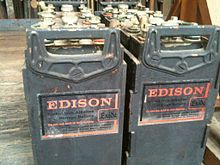Nickel-iron accumulator
The nickel-iron accumulator , also called Edison accumulator , was developed around 1900. It is considered to be durable and robust. It is related to the nickel-cadmium accumulator ; however, iron is used instead of the toxic cadmium . It is also related to the lithium iron phosphate accumulator , which has been used since the beginning of the 2010s.
Reaction / construction
The following reactions take place on the iron-nickel accumulator:
Load:
- 2 Ni (OH) 2 + 2 OH - → 2 NiO (OH) + 2 H 2 O + 2 e -
- Fe (OH) 2 + 2 e - → Fe + 2 OH -
The opposite reactions take place when discharging.
The accumulator is filled with 20 percent potassium hydroxide solution. Older designs used a glass vessel as the cell body; the necessary air exclusion (protection from carbon dioxide) was achieved by covering the electrolyte with a thin layer of oil . The second generation often used a welded sheet metal container, more modern forms a plastic housing. The air is sealed off here by a screwed-in pressure relief valve . This as well as the screw connections and the connecting straps are often made of nickel-plated iron.
When charging , the nickel electrode is covered with a black oxide layer, which disappears again when discharging. After charging, a voltage of typically around 1.3 volts can be measured between the electrodes , i.e. slightly lower than the end-of-charge voltage of the NiCd system of 1.4 V. The energy density is 19-25 Wh / kg (corresponding to 0.07 -0.09 MJ / kg).
history
The nickel-iron accumulator (NiFe accumulator) was developed almost simultaneously and independently of one another by the American Thomas Alva Edison and the Swede Waldemar Jungner . Jungner developed the nickel-iron accumulator a little later into the nickel-cadmium accumulator (NiCd accumulator) that is still widespread today . The first patents for the NiFe battery were granted in 1901 and series production was achieved in 1908. A long-term priority dispute, also regarding the NiCd battery from 1909, which emerged from the NiFe battery, ensued between the two inventors.
durability
Nickel-iron batteries have a very long lifespan of at least 8 years with high loads and up to 25 years with less loads. With good handling, 3000 to 4000 charging cycles are possible. For a long shelf life it is important that the temperature of the electrolyte does not rise above 45 ° C during charging.
Applications
The NiFe battery was used in mine lamps and in various motor vehicles. There were e.g. B. the option to buy a Detroit Electric with NiFe batteries from Edison. NiFe batteries are sometimes used in physical laboratories and schools.
Due to their extremely long service life, these batteries are mainly used for UPS systems and in rail vehicles.
The nickel-iron accumulator is considered to be mechanically and electrically insensitive. In particular, damage caused by overcharging or deep discharging , as is known from other accumulators, has a comparatively minor effect on these cells. These properties have led to a certain revival of technology in the field of decentralized power supply .
Research and development
Researchers in the USA have developed an electrode made of nickel hydroxide particles on graphene . The iron electrode turned out to be suitable and led to the rediscovery of the nickel-iron accumulator. Neither fast charging, overcharging nor deep discharging lead to damage.
In 2016, a variant of a nickel-iron accumulator was presented that is also capable of producing hydrogen by electrolysis . The cell can be charged and discharged like a conventional accumulator. If the battery reaches its capacity limit and electricity continues to be supplied, hydrogen is produced, which is then stored and available for other purposes. Laboratory results showed efficiencies of 80–90%, which is higher than that of conventional nickel-iron batteries and alkaline electrolysers. Tests also indicate that the cells have a very good shelf life. The cells are made from the abundant elements nickel and iron , noble catalysts such. B. Platinum in PEM electrolysers are not required. According to the authors of the study, the characteristics of the cells make them particularly suitable for short and long-term storage of wind and solar power as part of the energy transition .
literature
- David Linden, Thomas B. Reddy (Eds.): Handbook of Batteries . 3. Edition. McGraw-Hill, New York 2002, ISBN 0-07-135978-8 .
- Eberhard Zirngiebl: Introduction to applied electrochemistry (especially chapter 6.1.1.). Otto Salle, Frankfurt / Main 1993.
- R. Kinzelbach: Varta reference book series. Volume 1. Varta, Hanover 1974.
- Erich Witte: lead and steel accumulators . Krausskopf, Mainz 1967.
- Günter Krämer: Nickel-iron battery with high energy density . 1981, 163 pages.
Web links
- The nickel-iron (NiFe) battery
- The Nickel-Iron Battery. A Lifetime Battery For Your Off-Grid System or On-Grid Backup . ( Memento from November 13, 2012 in the Internet Archive ) BeUtilityFree (English)
- Edison's Nickel-iron Battery (English)
- US researchers improve Edison's nickel-iron battery
- New nickel-iron battery charges almost a thousand times faster . World of physics
Individual evidence
- ↑ Energy Density from NREL Testing by Iron Edison (PDF)
- ↑ Grimsehl: Textbook of Physics , Volume II. Leipzig 1954, p. 217.
- ↑ David Linden, Thomas B. Reddy: Handbook of Batteries 3rd Edition, McGraw-Hill, New York, 2002, Chapter 25, p. 730
- ↑ Sönke Gäthke : Revived classic - Edison battery as an alternative to the lithium-ion battery in dradio research from November 8, 2012
- ^ FM Mulder et al .: Efficient electricity storage with the battolyser, an integrated Ni-Fe-battery and electrolyser . In: Energy and Environmental Science . tape 10 , no. 3 , 2017, p. 756-764 , doi : 10.1039 / C6EE02923J .

